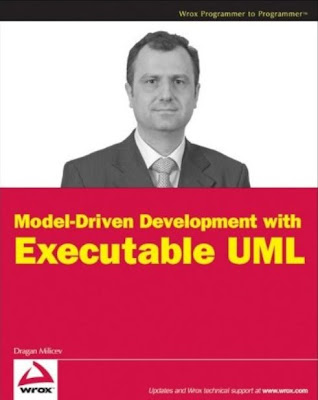Free E-book : Model-Driven Development with Executable UML
Free E-book : Model-Driven Development with Executable UML
Part I: Introduction
Chapter 1: Information Systems Modeling . .
Chapter 2: Traditional Approaches to IS Development .
Chapter 3: The Object Paradigm . . . . . . .
Part II: Overview of OOIS UML
Chapter 4: Getting Started . . . . . . . . . . . . . . . . . . . . . . . . . . . . . .
Chapter 5: Basic Language Concepts . . . . . . . .
Chapter 6: Interaction and Querying . . . . . . . . . . . . .
Part III: Concepts
Chapter 7: General Concepts . . . . . . . . . . . . . .
Chapter 8: Classes and Data Types . . . . . . . . . . . . . .
Chapter 9: Attributes . . . . . . . . . . . . . . . . . . . .
Chapter 10: Associations . . . . . . . . . . . . . . . .
Chapter 11: Constraints. . . . . . . . . . . . . . . . . . . . . . . .
Chapter 12: Querying . . . . . . . . . . . . . . . . . . . . . . . . . . .
Chapter 13: Operations and Methods . . . . . . . . . . . . . . . . . . . .
Chapter 14: StateMachines. . . . . . . . . . . . . . . . . . . . . . . . . .
Chapter 15: Collaborations and Interactions . . . . . . . . . . . . . . . . . . . . . . . . . . . . . . 517
Chapter 16: Commands, Presentation, and Architecture . . . . . . . . . . . . . . . . . . 547
Part IV: Method
Chapter 17: About theMethod . . . . . . . . . . . . . . . . . . . . .
Chapter 18: Conceptual Modeling . . . . . . . . . . . . . . . . . .
Chapter 19: Modeling Functional Requirements. . . . . . . . . . . . . . . . . . . . . . . . . . . 631
Part V: Supplemental
Chapter 20: Characteristics of Information Systems. . . . . . . . . . . . .
Chapter 21: Process and Principles of Software Development . . . . . . . . . . . . . 685
Chapter 22: The Relational Paradigm . . . . . . . . . . . . . .
Chapter 23: Structured Analysis . . . . . . . . . . . . . . . . . . . . . . .
Chapter 24: Introduction to the Object Paradigm .
*********
Information Systems Modeling
To provide a foundation for the discussions throughout this book, this chapter begins by defining what is actually meant by the term information system. The focus is on model-driven engineering of the software component of information systems. This chapter also introduces and describes the very notion of modeling. The chapter concludes with a brief discussion about software engineering processes, an important aspect of building successful information systems.
Definition of Information Systems
Information systems have played a key role in the history of computers and their use in everyday human activities. It is hard to imagine even a small company, institution, or organization that does not have a need for storing and using information of a different kind.
We are all witnesses of the tremendous improvement of computer and communication technology, which support ever-increasing demands of human community for interchanging and utilizing information. It is not necessary to discuss the role and importance of information systems such as healthcare systems, enterprise systems, banking and financial systems, educational information systems, customer-support systems, governmental systems, and many other kinds of information systems
Trying to catch up with the importance and ever-emerging demand for improved functionality and performance of such systems, the hardware and software technology for their implementation seem to constantly stay behind. It has always been a question of how to improve the technology (especially that for software development) to meet the users’ needs. Because this question defines the scope of this book, before trying to answer it, it is necessary to set up the context and define what information systems really are.
First and foremost, information systems are systems. A system is a set of elements organized to cooperate in order to accomplish a specific purpose. Elements of a systemcollaborate synergistically, in a manner that provides a behavior and quality bigger than the sum of its parts. It is likely that a....
Free E-book : Model-Driven Development with Executable UML



0 commentaires: